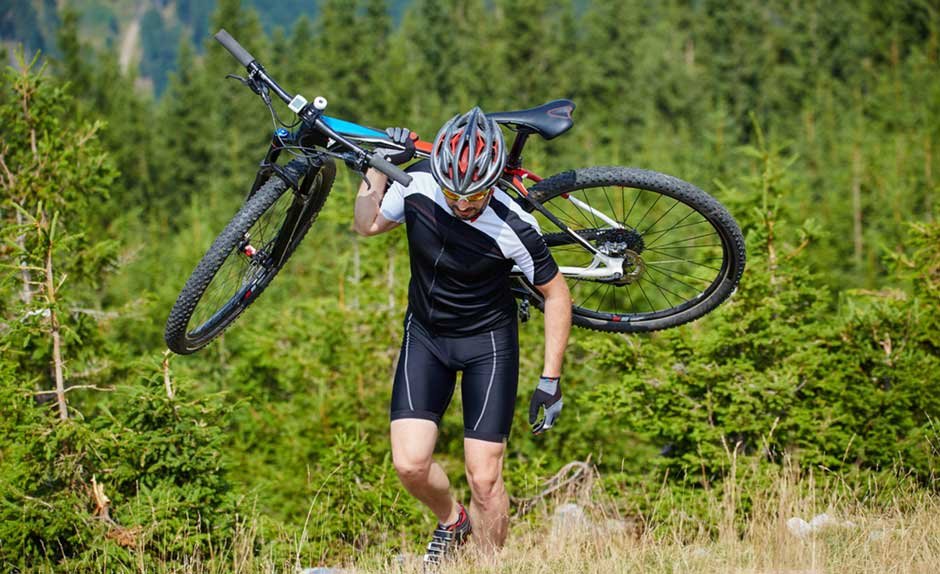Some 40 million Americans go mountain biking every year. What’s not to love? Open skies, unlimited terrain and free exercise. This sport has it all! But it can also be dangerous without the proper equipment. Falling is a common hazard regardless of where or how you like to ride, but the risk of injury increases when you are going downhill or riding along steep cliffs.
Research shows that 75 percent of mountain biking injuries are minor, but some can require hospitalization. You can help reduce your risk of serious injury by practicing proper riding etiquette. Use these essential mountain bike safety tips to steer clear of danger so you can get back up and go for another ride.
1. Wear the Proper Safety Equipment
It all starts with wearing the right safety equipment. You can get by with a regular bicycle helmet and goggles, but it’s best to use a full-face helmet with a visor so you can protect your chin and face from all the debris whipping through the air. Every inch of your skin should be covered with durable, water-resistant fabric to shield your skin from the elements. Wear flexible shoes that will give you a sense of the terrain instead of thick hiking boots.
2. Ride Within Your Means
You can choose your own adventure when mountain biking, but don’t bite off more than you can chew. Most trails come with difficulty ratings based on the intensity of the ride. Start off with the beginner trails until you reach the intermediate stage, which can take a year or more, even with regular riding. Use these mountain biking tips for beginners to get your bearings before your first ride.

If you’re exploring new territory, err on the side of caution and avoid taking overly risky routes. Some jumps and cliffs are just too dangerous to climb. Trust your instincts and make sure you and your gear are prepared for the challenge at hand.
3. Survey the Terrain
The natural world is full of mystery and wonder. That can make for a magical ride, but it can also ruin your plans for the day. Get to know the terrain before you depart by hiking the same route. Use this time to plan out your adventure and steer clear of hidden obstacles. If you can’t walk it, talk to other riders or the park manager to get a better idea of what lies ahead. You can even use a drone to get a bird’s-eye view of the trail.
Severe weather can also complicate the situation. Even if you know the path like the back of your hand, spend some time surveying the area for floods, fallen trees and slick surfaces. If the environment has changed since your last ride, look for an additional route.
4. Stay with a Group
You don’t have to master the trail all by yourself. There are literally millions of cyclists out there looking to share a ride. Tackling a mountain can be intimidating, but you will feel much more confident if there is another person around to watch your back.
You can talk to each other in real-time using a bike helmet with Bluetooth, so you can coordinate your location and radio one another for help in an emergency. You won’t be able to communicate without the headset when riding. If the trail is narrow, you’ll need to ride in single-file formation. Avoid using hand signals or looking away from the trail for any reason. You should be able to speak to the other person without putting your safety at risk.
5. Prepare for the Worst
Most mountain bikers agree that falling is an inevitability when riding on uneven terrain. Some areas will easily throw you for a loop even if you are doing everything right. That’s why you should go into the experience expecting to fall. You can avoid getting injured by wearing body armor and knee, shoulder and leg pads that will absorb the impact. Keep a first aid kit and gauze on hand to treat aches, sprains and cuts as soon as they occur. The same goes for your bike. Pack a multi-tool and bike repair kit to fix sudden issues. You should never try to ride a broken bike.
Learn how to fall correctly when you feel like you’re losing control to avoid landing in the wrong position. Experts recommend leaning your body away from whichever direction you’re falling to stay upright until the very last moment. Push the bike down with your hands and feet to make your bike bear the brunt of the fall. Give yourself a few minutes to assess yourself for injuries before getting back on your bike. Walk around to catch your breath to make sure you’re good to go.
Safe Travels
Use these safety tips to enjoy your new hobby without getting hurt. Stay vigilant on the trail and use the proper safety equipment so you can get home safe and sound.












